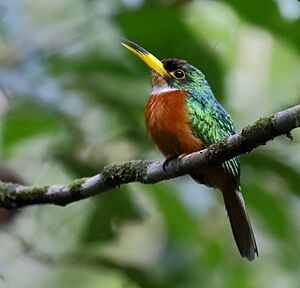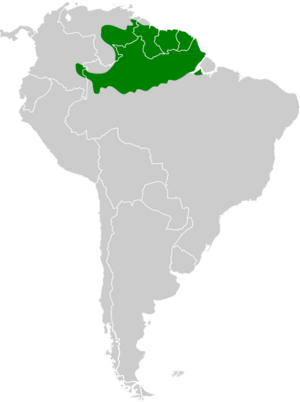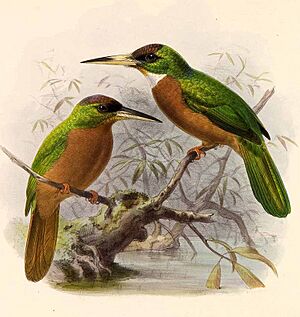Yellow-billed jacamar facts for kids
Quick facts for kids Yellow-billed jacamar |
|
|---|---|
 |
|
| A male yellow-billed jacamar at Presidente Figueiredo, Amazonas state, Brazil | |
| Conservation status | |
| Scientific classification | |
| Genus: |
Galbula
|
| Species: |
albirostris
|
 |
|
The yellow-billed jacamar (Galbula albirostris) is a beautiful bird that lives in the warm, green forests of South America. You can find it in countries like Brazil, Colombia, Ecuador, French Guiana, Guyana, Peru, Suriname, and Venezuela. This bird is known for its long, pointed bill and shiny feathers. It belongs to a family of birds called Galbulidae, which are often found in tropical areas.
Contents
About the Yellow-billed Jacamar's Family
Scientists like to group animals together to understand them better. The yellow-billed jacamar is part of the Galbula group of birds. For a while, scientists thought it was in its own special group, but then they decided it fit better with other Galbula birds.
The yellow-billed jacamar is very similar to the blue-necked jacamar. For a time, people even thought they were the same species! Now, scientists see them as two different but closely related birds. There are two main types, or subspecies, of the yellow-billed jacamar: the Galbula albirostris albirostris and the G. a. chalcocephala.
What Does the Yellow-billed Jacamar Look Like?
The yellow-billed jacamar is a medium-sized bird, usually about 18 to 21 cm (7.1 to 8.3 in) long. That's about the length of a pencil! It weighs between 16 to 24 g (0.56 to 0.85 oz), which is lighter than a small candy bar.
Colors of the Male and Female
The male bird has a shiny, copper or purplish crown on its head. The rest of its upper body is a bright emerald green. Its chin is a light tan color, and its throat is white. The rest of its belly and chest are a pale reddish-cinnamon color.
The female yellow-billed jacamar looks a bit different. Her underparts are usually paler, and her throat is a reddish-tan color instead of white.
Differences in Subspecies
The G. a. chalcocephala subspecies is also 18 to 21 cm (7.1 to 8.3 in) long, but it's usually a little lighter, weighing 16.9 to 22.9 g (0.60 to 0.81 oz). This type has a bronzy-purple crown and a darker bronzy-green back. Its chin is darker, and the reddish-cinnamon color on its belly is richer. For this subspecies, the male still has a white throat, but the female's throat is reddish-cinnamon.
Where Do Yellow-billed Jacamars Live?
Both types of yellow-billed jacamars live east of the Andes mountains and north of the Amazon River.
Homes of the albirostris Subspecies
The Galbula albirostris albirostris subspecies lives in a wide area. You can find it from eastern Colombia, through southern and eastern Venezuela, into countries like French Guiana, Guyana, and Suriname, and south into northern Brazil.
This subspecies likes different kinds of forests, including terra firme (dry land forests), várzea (flooded forests), and igapó (swampy forests). It lives in both old, untouched forests and newer, regrowing forests. Unlike many other jacamars, it prefers to stay inside the forest, not just at the edges. However, it does like open spots like clearings or where trees have fallen. It can also be found near rivers in gallery forest and in sandy forests along the coast. While it has been seen as high as 1,300 m (4,300 ft), it usually lives below 900 m (3,000 ft).
Homes of the chalcocephala Subspecies
The G. a. chalcocephala subspecies has similar needs for its home. It lives along the upper Orinoco River in southern Venezuela, south through southeastern Colombia, eastern Ecuador, and western Brazil, all the way to northeastern Peru.
In Ecuador and Peru, this subspecies seems to live only in terra firme forests. It has been seen up to 400 m (1,300 ft) in Ecuador and up to 800 m (2,600 ft) in Peru.
How Yellow-billed Jacamars Behave
What Do They Eat?
The yellow-billed jacamar loves to eat a wide variety of insects. It usually sits on branches that are easy to see, often in pairs. From there, it quickly flies out to catch insects in the air. Sometimes, it even joins groups of different bird species that are all looking for food together.
Reproduction and Life Cycle
Yellow-billed jacamars build their nests by digging burrows. The Galbula albirostris albirostris subspecies has been seen making nests in termite nests that are high up in trees. Scientists believe they also dig into earth banks, just like most other jacamars do. This subspecies usually nests during the dry season, which is from June to November. We don't know much yet about how the G. a. chalcocephala subspecies reproduces.
What Sounds Do They Make?
The yellow-billed jacamar has a unique song. It's described as a high-pitched sound like "peea peea-pee-pee-te-t-t-e'e'e'e'e'e'e" or "peea-pee-pee-te-t-t-t't't't't'ttttt'r'", which ends with a rattling sound. Their calls are sharp sounds like "peek," "tew," and "trra," sometimes made in a series.
Protecting the Yellow-billed Jacamar
The IUCN (International Union for Conservation of Nature) has looked at the yellow-billed jacamar and decided it is a species of "Least Concern." This means that, for now, there are still many of them, and they are not in immediate danger of disappearing. However, it's important to remember that these birds are sensitive to deforestation (when forests are cut down) and other ways their homes can be destroyed. Protecting their forest habitats is key to making sure they continue to thrive.



